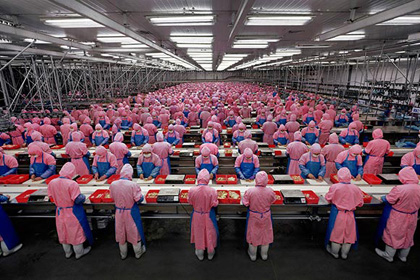In Maclean’s Jason Kirby writes about a surge of labor unrest that is quickly becoming a cause of concern for China’s leaders, just six years after a stimulus program helped quell rising unemployment and worker discontent. In 2008-2009, a series of protests hit China’s factories, notably in Tonghua, Henan where rioting workers facing layoffs beat a company executive to death . Kirby writes:
This time, however, the blunt tools policy-makers once deployed are no longer an option. The stimulus may have kept factories open, but wasteful investment spending spawned massive oversupply of capacity in many industrial sectors, created credit and housing bubbles that make even 2005-era America look thrifty and left China at risk of a Japanese-style lost decade of deflation.
Don’t be fooled by China’s still-impressive-sounding economic growth numbers. The country’s official bean counters claim China’s GDP is on track for seven per cent growth this year, a six-year low, yes, but an enviable figure nonetheless. The problem is, none but the most gullible believes even that reduced number is true. It simply bears no resemblance to what’s happening in China’s factories, shops and households. Consider this: In the first quarter of 2015, electricity growth in China expanded by just 0.2 per cent from the year before. Based on that metric, Christopher Balding, an associate business professor at Peking University in Shenzhen, recently suggested that China’s true GDP growth may be no more than one to three per cent.
At the same time, China, a country that came to be known as the world’s factory floor last decade thanks to its seemingly endless supply of cheap labour, now finds itself priced out of the market due to rising labour costs. Higher wages are a good thing if they can be sustained. But to the extent that they’re a by-product of artificially induced investment, higher labour costs may do more harm than good as companies turn to cheaper rivals like Mexico and Vietnam. [Source]
Another factor set to impact employment in Chinese factories is robotization of manual labor, as Martin Ford writes in the New York Times:
Automation has already had a substantial impact on Chinese factory employment: Between 1995 and 2002 about 16 million factory jobs disappeared, roughly 15 percent of total Chinese manufacturing employment. This trend is poised to accelerate.
That might not be a problem if the Chinese economy were generating plenty of higher-skill jobs for more educated workers. The solution, then, would simply be to offer more training and education to displaced blue-collar workers.
The reality, however, is that China has struggled to create enough white-collar jobs for its soaring population of college graduates. In mid-2013, the Chinese government revealed that only about half of the country’s current crop of college graduates had been able to find jobs, while more than 20 percent of the previous year’s graduates remained unemployed.
According to one analysis, fully 43 percent of Chinese workers already consider themselves to be overeducated for their current positions. As software automation and artificial intelligence increasingly affect knowledge-based occupations, especially at the entry level, it may well become even more difficult for the Chinese economy to absorb workers who seek to climb the skills ladder. [Source]
See also graphs compiled by political scientist Jay Ulfelder showing strike activity across China since 2011 (via CDT).








